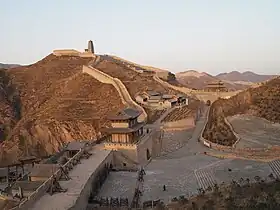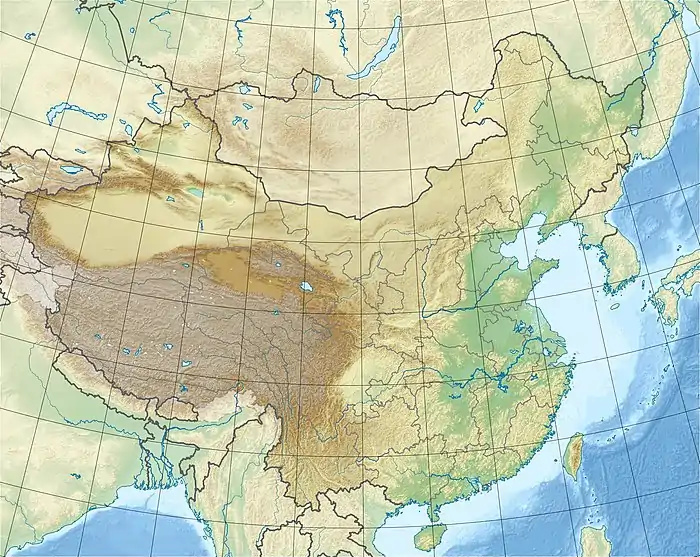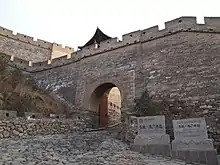Yanmen Pass
Yanmen Pass, also known by its Chinese name Yanmenguan and as Xixingguan, is a mountain pass which includes three fortified gatehouses along the Great Wall of China. The area was a strategic choke point in ancient and medieval China, controlling access between the valleys of central Shanxi and the Eurasian Steppe. This made it the scene of various important battles, extending into World War II, and the area around the gatehouses and this stretch of the Great Wall is now a AAAAA-rated tourist attraction. The scenic area is located just outside Yanmenguan Village in Yanmenguan Township in Dai County, Xinzhou City, Shanxi Province, China.[1]
| Yanmen Pass | |
|---|---|
 The Great Wall of China at Yanmen Pass, overlooked by a pagoda | |
| Location | Shanxi, China |
| Coordinates | 39°11′13″N 112°51′48″E |
 | |
| Yanmen Pass | |||||||||
|---|---|---|---|---|---|---|---|---|---|
 | |||||||||
| Traditional Chinese | 雁門關 鴈門關 | ||||||||
| Simplified Chinese | 雁门关 | ||||||||
| Postal | Yenmen Pass | ||||||||
| Literal meaning | Wild-Goose Gate Pass | ||||||||
| |||||||||
| Yanmenguan Township | |||||||||
| Traditional Chinese | 雁門關鄉 鴈門關鄉 | ||||||||
| Simplified Chinese | 雁门关乡 | ||||||||
| |||||||||
| Yanmenguan Village | |||||||||
| Traditional Chinese | 雁門關村 鴈門關村 | ||||||||
| Simplified Chinese | 雁门关村 | ||||||||
| |||||||||
| Other names | |||||||||
|---|---|---|---|---|---|---|---|---|---|
 | |||||||||
| Xixing Pass | |||||||||
| Traditional Chinese | 西陘關 | ||||||||
| Simplified Chinese | 西陉关 | ||||||||
| |||||||||
| Former names | |||||||||
|---|---|---|---|---|---|---|---|---|---|
| Shangtian | |||||||||
| Traditional Chinese | 上田鄉 | ||||||||
| Simplified Chinese | 上田乡 | ||||||||
| Literal meaning | Upper Fields Township Upon-the-Fields Township | ||||||||
| |||||||||
| Baicaokou | |||||||||
| Traditional Chinese | 白草口鄉 | ||||||||
| Simplified Chinese | 白草口乡 | ||||||||
| Literal meaning | White-Grass Mouth Township | ||||||||
| |||||||||
Name
Yanmen Pass, sometimes translated in English to Wild Goose Pass[2] or Wildgoose Gate,[3] is named after the wild geese who migrate through the area.[1] Yànménguān is the pinyin romanization of the Mandarin pronunciation of the Chinese placename written as 雁門關 or 鴈門關 in traditional characters and as 雁门关 in the simplified characters now used in mainland China. The same name was formerly written as Yen-mên-kuan in the Wade-Giles system and as Yenmen Pass by the Chinese Post Office.[4]
Geography
Yanmen is a pass in the Gouzhu or Yanmen[5] Mountains (a western extension of the Hengshan Range) between the Sanggan River (or Datong) Basin and the Hutuo River (or Xin ding) Basin.[6] The mountains form a natural climatic border, as well, with the Hutuo Valley's milder climate supporting rice cultivation and the Sanggan's colder and drier climate and more saline soil being less conducive to Chinese agriculture.[6] The village of Yanmenguan is about 20 kilometers (10 mi) from the county seat Shangguan (Daixian) and about 180 kilometers (110 mi) northeast of the provincial capital Taiyuan.[1] Once far distant, it now lies near the outskirts of the expanding metropolis of Datong to its northeast.[7]
History
Ancient China
King Yong of Zhao (posthumously known as the "Wuling" or "Martial-and-Numinous King") invaded and conquered the lands of the Loufan (t 樓煩, s 楼烦, Lóufán) and "forest nomads" (林胡, Línhú) tribes of modern northern Shanxi[8] in 306 and 304 BC. He organized these conquests as the commanderies of Yunzhong, Yanmen, and Dai and, by around 300 BC, had begun erecting earthen defensive works to protect his new holdings from other nomads from the Eurasian steppelands.[8][9] Although Zhao's Yanmen Commandery was named after the pass, whose premodern importance for accessing the valleys of central Shanxi caused it to be scene of many battles throughout Chinese history,[1] the ramparts raised under King Yong did not run through it but along the northern extent of his territory closer to today Hohhot in Inner Mongolia.[10][11] Yanmen itself was defended, but by a fort and garrison on a local hill.[1]
Imperial China
At some point during the reign of the First Emperor of Qin (221–210 BC), a Chu noble named Ban Yi (斑 or 班壹, Bān Yī) fled north to the Loufan near Yanmen.[12] By the early Han Dynasty, his clan had grown rich through herding and trading thousands of heads of cattle and horses,[13] to the point that they may have formed a microstate of their own.[14] The example of their success encouraged greater Chinese settlement of the frontier around Yanmen.[13] The markets were not always safe: In the fall of 129 BC, 40,000 horsemen of the Han Empire massacred the Xiongnu trading at markets along the frontier;[15] (The heavy defeats of Li Guang and Gongsun Ao near Yanmen, however, had them narrowly escape execution through the payment of large fines and their demotion to common status.) The next year[16] or the year after,[15] Wei Qing and 30,000 men rode north from Yanmen and defeated the Xiongnu left in the area,[16] taking control of the entire Ordos Loop.[15] 100,000 Chinese were sent to colonize the area.[15] In 127 BC, the Xiongnu defeated and killed the governor of Liaoxi; Han Anguo (t 韓安國, s 韩安国, Hán Ānguó) tried to hold them near Yanmen with 700 men but was defeated and forced to withdraw to Yuyang.[17] Wei Qing and Li Xi returned to the area in force, capturing some Xiongnu and forcing the rest to withdraw beyond the frontier.[17] The Ban clan ultimately left the tumultuous area and used their accumulated wealth to rise to prominence among the officials of the Eastern Han by the 1st century AD.[18]
A line of the Great Wall was finally built through the pass by the Northern Qi in AD 557.[19] It was part of a massive public works project involving more than 1.8 million laborers ordered by the emperor Gao Yang (posthumously known as the "Wenxuan" or "Civil-&-Responsible Emperor"), intended to protect his realm from the inimical Northern Zhou.[19] As with the later Ming Great Wall, the Northern Qi's Yanmen wall formed an inner line of defense; it was repaired and expanded in 565.[19] Despite its strong defenses, the state itself fell into chaos and was consumed by the Northern Zhou in the late 570s. The retired emperor Yuwen Chan (posthumously known as the "Xuan" or "Responsible Emperor"), acting on behalf of his young successor Yuwen Yun (posthumously the "Jing" or "Silent Emperor"), refortified the wall between Yanmen and Jieshi in 579 to protect Northern China from the Blue Turks and the Khitans.[19] Upon Yuwen Chan's death in 580, his father-in-law Yang Jian seized power, eventually declaring himself the first emperor of the Sui.[19]
The Sui (581–618) rulers regarded the Great Wall as an essential line of defense and ordered large-scale repairs 7 times, but their successors the Tang (618–907) expanded China far to its north, and allowed it to fall into disuse and decay.[19] Following the collapse of the later Tang and its short-lived successor later Han of Five dynasties and Ten Kingdoms era, most of the lands around Shanxi were controlled from Taiyuan by Liu Chong as the Northern Han. Zhao Kuangyin (posthumously known as "Emperor Taizu" or "the Great Ancestor") unified most of China proper as the Song Empire prior to his death in 976, and his younger brother and successor Zhao Jiong (posthumously "Emperor Taizong", also meaning "the Great Ancestor") invaded the Northern Han in 978 and conquered it the next year. In 980, roughly 100,000 nomad horsemen of the Khitan Empire (known to the Chinese as the Liao) invaded Shanxi under their general Li Chonghui (t 李重誨, s 李重诲, Lǐ Chónghuì) and on behalf of their defeated allies. Arriving before Yanmen, Li and his men were encircled and catastrophically defeated by the Song generals Yang Ye and Pan Mei[20] outside the fortress at Baicao Lingkou.[21] The victory killed the Khitan emperor's brother-in-law Xiao Chuoli (t 蕭啜裏, s 萧啜里, Xiāo Chuòlǐ), won Song innumerable horses and war equipment, and secured its new conquests and northern border.[20]
Under the Mongolian Yuan Dynasty, the great khan nominally controlled the peoples on both sides of the wall and its fortifications were fallen into disrepair.[1] Under the Ming, it was reconstructed as part of the Inner Great Wall in 1374 and these are the defensive works seen today.[1] It is one of the few stone stretches of the wall left in Shanxi.[21]
Modern China
During the Second Sino-Japanese War (the Chinese theater of World War II), He Bingyan led[22] the 716th Regiment of his 358th Brigade of He Long's 120th Division of the Eighth Route Army in an ambush the Imperial Japanese Army forces at Yanmen Pass on 18 October 1937 as part of the ongoing battles of Xinkou. The regiment killed 300 Japanese and destroyed 20 vehicles, then held the area as part of an attempt to cut Japanese lines of supply and communication as they pushed forward to Taiyuan.[23] There was also a skirmish during the night of 20 October, then an assault on a second supply column the next day. This supposedly took out around 200 Japanese and "hundreds" of vehicles.[23] The Japanese were then obliged to begin air assaults and dedicate the Ushiromiya Division to push He's men further north.[23]
Following the war, Yanmen Pass was reckoned as part of the boundary of China's "Third Front", which was used by national authorities in planning infrastructure investment and military defenses. Yanmen Township was created in 2001 from the merger of parts of some of Dai County's smaller settlements, particularly Shangtian and Baicaokou. The Yanmen Pass Scenic Area was named a AAAAA attraction by the China National Tourism Administration in 2017.[24]
Administrative divisions
Yanmenguan Township oversees Yanmenguan and 27 other villages:[25]
| Name | Simp. | Trad. | Pinyin |
|---|---|---|---|
| Shangtian | 上田村 | 上田村 | Shàngtiáncūn |
| Dianshang | 殿上村 | 殿上村 | Diànshǎngcūn |
| Chenjiazhuang | 陈家庄村 | 陳家莊村 | Chénjiāzhuāng Cūn |
| Xiduan | 西段村 | 西段村 | Xīduàncūn |
| Beixinzhuang | 北新庄村 | 北新莊村 | Běixīnzhuāng Cūn |
| Yezhuang | 野庄村 | 野莊村 | Yězhuāngcūn |
| Beiwangzhuang | 北王庄村 | 北王莊村 | Běiwángzhuāng Cūn |
| Zhangjiahe | 张家河村 | 張家河村 | Zhāngjiāhé Cūn |
| Xiwa Yaotou | 西瓦窑头村 | 西瓦窯頭村 | Xīwǎ Yáotóu Cūn |
| Qianyaopu | 前腰铺村 | 前腰鋪村 | Qiányāopù Cūn |
| Nankou | 南口村 | 南口村 | Nánkǒucūn |
| Taihe Lingkou | 太和岭口村 | 太和嶺口村 | Tàihé Lǐngkǒu Cūn |
| Shidaoshi | 试刀石村 | 試刀石村 | Shìdāoshí Cūn |
| Baicaokou | 白草口村 | 白草口村 | Báicǎokǒu Cūn |
| Qinzhuang | 秦庄村 | 秦莊村 | Qínzhuāngcūn |
| Wangzhuang | 王庄村 | 王莊村 | Wángzhuāngcūn |
| Xiaogou | 小沟村 | 小溝村 | Xiǎogōucūn |
| Dongshuiquan | 东水泉村 | 東水泉村 | Dōngshuǐquán Cūn |
| Zhaozhuang | 赵庄村 | 趙莊村 | Zhàozhuāngcūn |
| Mabu Daigou | 麻布袋沟村 | 麻布袋溝村 | Mábù Dàigōu Cūn |
| Houyaopu | 后腰铺村 | 後腰鋪村 | Hòuyāopù Cūn |
| Gao'ergou | 高二沟村 | 高二溝村 | Gāo'èrgōu Cūn |
| Yanmenguan | 雁门关村 | 鴈門關村 鴈門關村 | Yànménguān Cūn |
| Dayugou | 大峪沟村 | 大峪溝村 | Dàyùgōu Cūn |
| Liulin | 柳林村 | 柳林村 | Liǔlíncūn |
| Laoxinggou | 老杏沟村 | 老杏溝村 | Lǎoxìnggōu Cūn |
| Hongqiang | 红墙村 | 紅牆村 | Hóngqiángcūn |
| Xintian | 新田村 | 新田村 | Xīntiáncūn |
Sites
Yanmen was formerly reckoned as the first of the "Nine Passes under Heaven".[1] The preserved Ming fortifications are about 1 kilometer (0.6 mi) long and 4 meters (13 ft) high.[1] It includes three fortified gatehouses. The western gate is called Dili ("Chosen Battleground"), the central gate is Yanmen proper, and the eastern gate is Tianxian ("Impregnable Fortress").[1] They are open to the public from 8 am to 6:30 pm.[1][26]
The fortifications in the Yanmen Pass form part of the defenses of the "inner line" of the Great Wall,[1] along with the Ningwu (t 寧武關, s 宁武关, Níngwǔguān) and Pian (t 偏關, s 偏关, Piānguān) or Piantou Passes (t 偏頭關, s 偏头关, Piāntóuguān).[26] Under the Ming and Qing, however, these were reckoned as the Outer Three Passes (t 外三關, s 外三关, Wàisānguān) based on their greater distance from the capital at Beijing, contrasted with the "Inner Three Passes" at Juyong, Zijing, and Daoma.
The Zhenbian Hall is a temple to Li Mu, a Zhao general, beside the Tianxian Gate. It has also been used by local Buddhists since 1856, when the monk Shan Quan began holding services there.[26] There is a temple to Guan Yu, the Chinese god of war, beside the Dili Gate.[26] There was also a frontier market between Yanmenguan Village and the Dili Gate. A flagstone path called "Frontier Trade Street" continues to be lined with hostels[7] and various shops for tourists.[26] Statues of the generals of the Yang Clan line one of the pathways of the site.[7]
The ruins of Guangwu, the former county seat for the area, are nearby.[6] Its remains include Han-era tombs in mounds 2–10 meters (6 ft 7 in – 32 ft 10 in) high.[6] They were excavated by Japanese archaeologists in the early 20th century and have been studied by the Chinese in the 1980s; a tomb robber around that time was caught and exposed that the mounds were not for local elites but for group burial in urns.[6]
Transportation
The Datong–Yuncheng Expressway runs through part of Yanmen Pass. The village of Yanmenguan is connected to the county seat Daixian by bus. The main fortification is about 2 kilometers (1.2 mi) outside of town, reached by walking[1] or shuttle bus.[26] The general inconvenience of transportation to the site means that it is less crowded than other well-known sites along the wall.[1][2]
Popular media
The Battle of Yanmen Pass is an important moment in the Chinese legends, folktales, and plays collectively known as The Generals of the Yang Family. Likewise, because of its strategic importance to ancient and medieval China, Yanmen Pass and its fortifications feature prominently in some Chinese historical fiction novels, including Louis Cha's Demi-Gods and Semi-Devils, and films, including Daniel Lee's 14 Blades.
References
Citations
- CIIC (2015).
- Evans (2006), p. 183
- Wen (2003), p. 16.
- Stanford (1917), p. 15.
- Hing Ming (2011), p. 197.
- Lu (2017).
- Sun & al. (2016).
- Di Cosmo (2002), p. 143
- Yü (1990), p. 118
- Jing (2015), pp. 34–5.
- Di Cosmo (2002), p. 147.
- Loewe (2000).
- Yü (1967), p. 8.
- Clark (2008), p. 229.
- Yü (1986), p. 390
- Whiting (2002), p. 147.
- Whiting (2002), p. 148.
- Knechtges (2010), p. 119.
- Pletcher (2010), p. 94
- Xu Zizhi Tongjian Changbian, ch. 21
- Evans (2006), p. 194
- Yang (2018).
- Wortzel (1999), s.v. "Yanmen Guan Ambush"
- Hunan (2017).
- "代县行政区划", 《行政区划网》, 21 October 2016. (in Chinese)
- TCG.
Bibliography
- "Yanmen Pass of the Great Wall", Official site, Beijing: China Internet Information Center, 21 April 2015.
- "20 National Tourist Attractions Receive 5A-Level Classification", Official site, Changsha: Hunan Provincial People's Government, 20 February 2017.
- "Yanmenguan Great Wall", Travel China Guide, Xi'an.
- Clark, Anthony E. (2008), Ban Gu's History of Early China, Amherst: Cambria Press, ISBN 9781621969730.
- Di Cosmo, Nicola (2002), Ancient China and Its Enemies: The Rise of Nomadic Power in East Asian History, Cambridge: Cambridge University Press, ISBN 9780521543828.
- Evans, Thammy (2006), Great Wall of China: Beijing & Northern China, Chalfont St Peter: Brandt Travel Guides, ISBN 9781841621586.
- Hung Hing-Ming (2011), The Road to the Throne: How Liu Bang Founded China's Han Dynasty, New York: Algora Publishing, ISBN 9780875868387.
- Jing Ai (2015), Wang Gangliu; et al. (eds.), A History of the Great Wall of China, New York: SCPG Publishing, ISBN 9781938368325.
- Knechtges, David Richard (2010), "Ban Gu", Ancient and Early Medieval Chinese Literature: A Reference Guide, Pt. I, Leiden: Brill.
- Li Tao (1183), Xu Zizhi Tongjian Changbian|《續資治通鑑長編》 [Xu Zizhi Tongjian Changbian, Extended Continuation of the Zizhi Tongjian]. (in Chinese)
- Loewe, Michael (2000), "Ban Yi", A Biographical Dictionary of the Qin, Former Han, and Xin Periods (221 BC – AD 24), Handbook of Oriental Studies, Sect. IV: China, No. 16, Leiden: Brill.
- Lu Shunming (19 May 2017), "The Yanmenguan Great Wall", China Scenic, vol. No. 115, Beijing: Chinese National Geography Press.
- Pletcher, Kenneth (2010), "Great Wall of China", The Geography of China: Sacred and Historic Places, Understanding China, New York: Britannica Educational Publishing, pp. 90–97, ISBN 9781615301348.
- Stanford, Edward (1917), Complete Atlas of China, 2nd ed., London: China Inland Mission.
- Sun Ruisheng; et al. (2 November 2016), "Yanmen Fort Helps Shanxi Win the Battle for Its Soul", China Daily Asia, Beijing: China Daily Information Co.
- Wen, Robert K. (2003), Leaves upon the River, Lincoln: iUniverse, ISBN 9780595277094.
- Whiting, Marvin C. (2002), Imperial Chinese Military History: 8000 BC – 1912 AD, Lincoln: iUniverse, ISBN 978-0-595-22134-9.
- Wortzel, Larry M. (1999), Dictionary of Contemporary Chinese Military History, Westport: Greenwood, ISBN 9780313293375.
- Yang Chan (2018), World War Two Legacies in East Asia: China Remembers the War, Routledge Studies in the Modern History of Asia, Abingdon: Routledge, ISBN 9781351391504.
- Yü Ying-shih (1967), Trade and Expansion in Han China: A Study in the Structure of Sino-Barbarian Economic Relations, Berkeley: University of California Press.
- Yü Ying-shih (1986), "Han Foreign Relations", The Cambridge History of China, Vol. I: The Ch'in and Han Empires, 221 B.C. – A.D. 220, Cambridge: Cambridge University Press, pp. 377–462, ISBN 0-521-24327-0.
- Yü Ying-shih (1990), "The Hsiung-nu", The Cambridge History of Early Inner Asia, Vol. I: From the Earliest Times to the Rise of the Mongols, Cambridge: Cambridge University Press, pp. 118–150, ISBN 9780521243049.